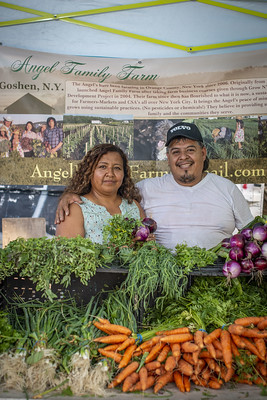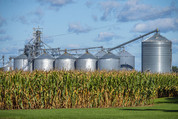|
Feb 20
|
All Service Centers Closed for Washington's Birthday
|
|
Mar 15
|
NAP Coverage Deadline for most spring planted fruits and vegetables such as beans, broccoli, cabbage, cantaloupe, carrots, cauliflower, cucumbers, eggplant, hemp, hops, peppers, pumpkins, sweet corn, tomatoes, and watermelon.
|
|
Mar 15
|
ARC/PLC Annual Enrollment Deadline
|
|
Mar 31
|
Marketing Assistance Loans and Loan Deficiency Payments Deadline for prior year harvested wheat, barley and oats
|
|
Ongoing
|
Conservation Reserve Program (CRP) - Continuous Enrollment
|

The U.S. Department of Agriculture (USDA) Farm Service Agency (FSA) is currently making automatic Coronavirus Food Assistance Program 2 (CFAP 2) top-up payments to underserved farmers and ranchers. Payments will be based on the 2020 program certification on form CCC-860, Socially Disadvantaged, Limited Resource, Beginning and Veteran Farmer or Rancher Certification.
Producers who have not previously certified to their status for the 2020 program year have until Feb. 10, 2023, to submit form CCC-860 to be eligible for the additional payments. Contact your local USDA Service Center for more information.
|
A series of free webinars will be presented by the U.S. Department of Agriculture’s (USDA) Farm Service Agency (FSA) in New York State. FSA Fridays in February will cover a variety of programs and services FSA offers agricultural producers in New York. Topics include an overview of available programs and loans, conservation, disaster programs and loan programs.
The hour-long webinars will be held every Friday in February at noon. The webinars are free however pre-registration is required to get a link to each webinar. Everyone who registers will receive a link to a recording of the webinar afterwards. Please register at: https://fsafridays23.eventbrite.com or by emailing lynnette.wright@usda.gov.
Summary of each FSA Friday in February:
Friday, February 10 at 12 p.m.: FSA Farm Loans – an overview of the funding opportunities available from FSA’s Farm Loan Programs, including information on microloans, operating loans, ownership loans and guaranteed loans.
Friday, February 17 at 12 p.m.: All About the Conservation Reserve Program (CRP) – The Conservation Reserve Program (CRP) provides farmers and landowners with several opportunities to achieve many conservation goals. In this webinar we’ll discuss all the opportunities, including the State Acres for Wildlife Enhancement (SAFE) Initiative specific to New York. SAFE restores vital habitat to meet high-priority state wildlife conservation goals.
Friday, February 24 at 12 p.m.: ERP Phase 2 and PARP – FSA has announced two new programs that wrap-up and fill remaining gaps in previous natural disaster and pandemic assistance. On the final Friday of February, learn more about the Emergency Relief Program (ERP) Phase 2 and Pandemic Assistance Revenue Program (PARP).
FSA provides programs and loans to help farmers provide food, fuel, and fiber to millions of people worldwide. The New York FSA staff work hard every day to ensure that New York farmers have the information they need to participate in federally funded agricultural programs. FSA-administered programs benefit all Americans by providing stability for our agricultural producers, thus helping ensure a safe, abundant, and affordable supply of food and fiber.
If you would need to request an accommodation, please contact Lynnette Wright at (315) 477-6309, or by e-mail at lynnette.wright@usda.gov at least three days prior to the webinar to request accommodations (e.g., an interpreter, translator, etc.) or materials in an alternative format (e.g., Braille, large print, audiotape – captioning, etc.).
The U.S. Department of Agriculture (USDA) has developed a simplified direct loan application to provide improved customer experience for producers applying for loans from the Farm Service Agency (FSA). The simplified direct loan application enables producers to complete a more streamlined application, reduced from 29 to 13 pages. Producers will also have the option to complete an electronic fillable form or prepare a traditional, paper application for submission to their local FSA farm loan office. The paper and electronic versions of the form will be available starting March 1, 2023.
Approximately 26,000 producers submit a direct loan application to the FSA annually, but there is a high rate of incomplete or withdrawn applications, due in part to a challenging and lengthy paper-based application process. Coupled with the Loan Assistance Tool released in October 2022, the simplified application will provide all loan applicants access to information regarding the application process and assist them with gathering the correct documents before they begin the process. This new application will help farmers and ranchers submit complete loan applications and reduce the number of incomplete, rejected, or withdrawn applications.
In October 2022, USDA launched the Loan Assistance Tool, an online step-by-step guide that provides materials to help an applicant prepare their farm loan application in one tool. Farmers can access the Loan Assistance Tool by visiting farmers.gov/farm-loan-assistance-tool and clicking the ‘Get Started’ button. The tool is built to run on any modern browser like Chrome, Edge, Firefox, or the Safari browser. A version compatible with mobile devices is expected to be available by the summer. It does not work in Internet Explorer.
The simplified direct loan application and Loan Assistance Tool are the first of multiple farm loan process improvements that will be available to USDA customers on farmers.gov in the future. Other improvements that are anticipated to launch in 2023 include:
- An interactive online direct loan application that gives customers a paperless and electronic signature option, along with the ability to attach supporting documents such as tax returns.
- An online direct loan repayment feature that relieves borrowers from the necessity of calling, mailing, or visiting a local Service Center to pay a loan installment.
USDA provides access to credit to approximately 115,000 producers who cannot obtain sufficient commercial credit through direct and guaranteed farm loans. With the funds and direction Congress provided in Section 22006 of the Inflation Reduction Act, USDA took action in October 2022 to provide relief to qualifying distressed borrowers while working on making transformational changes to loan servicing so that borrowers are provided the flexibility and opportunities needed to address the inherent risks and unpredictability associated with agricultural operations.
Soon, all direct loan borrowers will receive a letter from USDA describing the circumstances under which additional payments will be made to distressed borrowers and how they can work with their FSA local office to discuss these options. Producers can explore all available options on all FSA loan options at fsa.usda.gov or by contacting their local USDA Service Center.

Agricultural producers can now change election and enroll in the Agriculture Risk Coverage (ARC) and Price Loss Coverage programs for the 2023 crop year, two key safety net programs offered by the U.S. Department of Agriculture (USDA). Signup began Oct. 17, 2022, and producers have until March 15, 2023, to enroll in these two programs. Additionally, USDA’s Farm Service Agency (FSA) has started issuing payments totaling more than $255 million to producers with 2021 crops that have triggered payments through ARC or PLC.
2023 Elections and Enrollment
Producers can elect coverage and enroll in ARC-County (ARC-CO) or PLC, which provide crop-by-crop protection, or ARC-Individual (ARC-IC), which protects the entire farm. Although election changes for 2023 are optional, producers must enroll through a signed contract each year. Also, if a producer has a multi-year contract on the farm and makes an election change for 2023, they must sign a new contract.
If producers do not submit their election by the March 15, 2023 deadline, their election remains the same as their 2022 election for crops on the farm. Farm owners cannot enroll in either program unless they have a share interest in the farm.
Covered commodities include barley, canola, large and small chickpeas, corn, crambe, flaxseed, grain sorghum, lentils, mustard seed, oats, peanuts, dry peas, rapeseed, long grain rice, medium and short grain rice, safflower seed, seed cotton, sesame, soybeans, sunflower seed and wheat.
Web-Based Decision Tools
In partnership with USDA, the University of Illinois and Texas A&M University offer web-based decision tools to assist producers in making informed, educated decisions using crop data specific to their respective farming operations. Tools include:
-
Gardner-farmdoc Payment Calculator, a tool available through the University of Illinois allows producers to estimate payments for farms and counties for ARC-CO and PLC.
-
ARC and PLC Decision Tool, a tool available through Texas A&M that allows producers to obtain basic information regarding the decision and factors that should be taken into consideration such as future commodity prices and historic yields to estimate payments for 2022.
2021 Payments and Contracts
ARC and PLC payments for a given crop year are paid out the following fall to allow actual county yields and the Market Year Average prices to be finalized. This month, FSA processed payments to producers enrolled in 2021 ARC-CO, ARC-IC and PLC for covered commodities that triggered for the crop year.
For ARC-CO, producers can view the 2021 ARC-CO Benchmark Yields and Revenues online database, for payment rates applicable to their county and each covered commodity. For PLC, payments have triggered for rapeseed and peanuts.
For ARC-IC, producers should contact their local FSA office for additional information pertaining to 2021 payment information, which relies on producer-specific yields for the crop and farm to determine benchmark yields and actual year yields when calculating revenues.
By the Numbers
In 2021, producers signed nearly 1.8 million ARC or PLC contracts, and 251 million out of 273 million base acres were enrolled in the programs. For the 2022 crop year signed contracts surpassed 1.8 million, to be paid in the fall of 2023, if a payment triggers.
Since ARC and PLC were first authorized by the 2014 Farm Bill and reauthorized by the 2018 Farm Bill, these safety-net programs have paid out more than $34.9 billion to producers of covered commodities.
Crop Insurance Considerations
ARC and PLC are part of a broader safety net provided by USDA, which also includes crop insurance and marketing assistance loans.
Producers are reminded that ARC and PLC elections and enrollments can impact eligibility for some crop insurance products.
Producers on farms with a PLC election have the option of purchasing Supplemental Coverage Option (SCO) through their Approved Insurance Provider; however, producers on farms where ARC is the election are ineligible for SCO on their planted acres for that crop on that farm.
Unlike SCO, the Enhanced Coverage Option (ECO) is unaffected by an ARC election. Producers may add ECO regardless of the farm program election.
Upland cotton farmers who choose to enroll seed cotton base acres in ARC or PLC are ineligible for the stacked income protection plan (STAX) on their planted cotton acres for that farm.
More Information
For more information on ARC and PLC, visit the ARC and PLC webpage or contact your local USDA Service Center.
|

The 2018 Farm Bill extends loan authority through 2023 for Marketing Assistance Loans (MALs) and Loan Deficiency Payments (LDPs).
MALs and LDPs provide financing and marketing assistance for wheat, feed grains, soybeans, and other oilseeds, pulse crops, rice, peanuts, cotton, wool and honey. MALs provide you with interim financing after harvest to help you meet cash flow needs without having to sell your commodities when market prices are typically at harvest-time lows. A producer who is eligible to obtain a loan, but agrees to forgo the loan, may obtain an LDP if such a payment is available. Marketing loan provisions and LDPs are not available for sugar and extra-long staple cotton.
FSA is now accepting requests for 2022 MALs and LDPs for all eligible commodities after harvest. Requests for loans and LDPs shall be made on or before the final availability date for the respective commodities.
Commodity certificates are available to loan holders who have outstanding nonrecourse loans for wheat, upland cotton, rice, feed grains, pulse crops (dry peas, lentils, large and small chickpeas), peanuts, wool, soybeans and designated minor oilseeds. These certificates can be purchased at the posted county price (or adjusted world price or national posted price) for the quantity of commodity under loan, and must be immediately exchanged for the collateral, satisfying the loan. MALs redeemed with commodity certificates are not subject to Adjusted Gross Income provisions.
To be considered eligible for an LDP, you must have form CCC-633EZ, Page 1 on file at your local FSA Office before losing beneficial interest in the crop. Pages 2, 3 or 4 of the form must be submitted when payment is requested.
Marketing loan gains (MLGs) and loan deficiency payments (LDPs) are no longer subject to payment limitations, actively engaged in farming and cash-rent tenant rules.
Adjusted Gross Income (AGI) provisions state that if your total applicable three-year average AGI exceeds $900,000, then you’re not eligible to receive an MLG or LDP. You must have a valid CCC-941 on file to earn a market gain of LDP. The AGI does not apply to MALs redeemed with commodity certificate exchange.
For more information and additional eligibility requirements, contact your local USDA Service Center or visit fsa.usda.gov.
|

The USDA Farm Service Agency (FSA) encourages you to review available USDA crop risk protection options, including federal crop insurance and Noninsured Crop Disaster Assistance Program (NAP) coverage, before the crop deadline of March 15, 2023.
Federal crop insurance covers crop losses from natural adversities such as drought, hail and excessive moisture. NAP covers losses from natural disasters on crops for which no permanent federal crop insurance program is available.
The following crops in [NAME] County have a NAP application deadline of March 15, 2023: Spring Seeded Crops (ex. Beans, broccoli, cabbage, cantaloupe, carrots, cauliflower, corn, cucumbers, eggplant, hemp, hops, peppers, pumpkins, soybeans, tomatoes, watermelon)
You can determine if crops are eligible for federal crop insurance or NAP by visiting the RMA website.
NAP offers higher levels of coverage, from 50 to 65 percent of expected production in 5 percent increments, at 100 percent of the average market price. Producers of organics and crops marketed directly to consumers also may exercise the “buy-up” option to obtain NAP coverage of 100 percent of the average market price at the coverage levels of between 50 and 65 percent of expected production. NAP basic coverage is available at 55 percent of the average market price for crop losses that exceed 50 percent of expected production.
For all coverage levels, the NAP service fee is the lesser of $325 per crop or $825 per producer per county, not to exceed a total of $1,950 for a producer with farming interests in multiple counties.
Beginning, underserved, veterans and limited resource farmers are now eligible for free catastrophic level coverage.
Federal crop insurance coverage is sold and delivered solely through private insurance agents. Agent lists are available at all USDA Service Centers or at USDA’s online Agent Locator. You can use the USDA Cost Estimator to predict insurance premium costs.
For more information on NAP, service fees, sales deadlines, contact your local USDA Service Center or visit fsa.usda.gov.
|

Farmers can use USDA farm ownership microloans to buy and improve property. These microloans are especially helpful to beginning or underserved farmers, U.S. veterans looking for a career in farming, and those who have small and mid-sized farming operations.
Microloans have helped farmers and ranchers with operating costs, such as feed, fertilizer, tools, fencing, equipment, and living expenses since 2013.
Microloans can also help with farmland and building purchases and soil and water conservation improvements. FSA designed the expanded program to simplify the application process, expand eligibility requirements and expedite smaller real estate loans to help farmers strengthen their operations. Microloans provide up to $50,000 to qualified producers and can be issued to the applicant directly from the USDA Farm Service Agency (FSA).
To learn more about the FSA microloan program, contact your local USDA Service Center or visit fsa.usda.gov/microloans.
|
Did you know that farmers are more likely than the general population to die by suicide?
NY FarmNet is continuing its collaboration with county Cornell Cooperative Extension offices and other ag related organizations this spring to offer free, full day, adult Mental Health First Aid (MHFA) trainings. Farmers, agribusiness workers, and anyone who interacts with the agricultural community in New York is encouraged to attend. Trainings run from 8am to 5pm (unless otherwise noted), and lunch will be provided from a local eatery with a one hour break.
Mental Health First Aid teaches you how to identify, understand, and respond to signs of mental health and substance use challenges among adults. You’ll build skills and confidence you need to reach out and provide initial support to those who are struggling. You’ll also learn how to help connect them to appropriate support.
After the course, you will be able to:
- Recognize common signs and symptoms of mental health and substance use challenges.
- Understand how to interact with a person in crisis and connect them with help.
- Use self-care tools and techniques.
The instructors for these courses are part of a recently trained cohort that work within the NY agricultural community. They include representatives from NY FarmNet, Cornell Cooperative Extension, Farm Bureau, Young Farmers Coalition, Black Farmers United NYS, and the NY Center for Ag Medicine and Health (NYCAMH). Please note that the adult MHFA content is not ag specific, although the instructors are.
Full day MHFA trainings scheduled for 2023 include:
Wednesday, February 8th in Herkimer/Herkimer County
Friday, February 17th in Canton/St. Lawrence County
Tuesday, February 28th in Lowville/Lewis County
Friday, March 3rd in Albany/Albany County – 2 hours pre-work, 6 hour session (9:30am-4:30pm)
Tuesday, March 14th in Jamestown/Chautauqua County
Saturday, March 25th in Dover Plains/Dutchess County
Friday, April 21st in Morrisville/Madison County
To register for one of these trainings, go to www.nyfarmnet.org/trainings or call 1-800-547-3276. These free sessions are made possible by funding from the United States Department of Agriculture’s National Institute of Food & Agriculture. They have invested nearly $25 million in addressing farmer behavioral health on a state by state basis as part of the Farm and Stress Assistance Network (FRSAN) through state Departments of Agriculture.
|